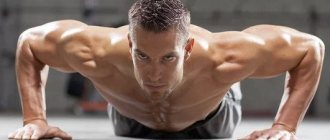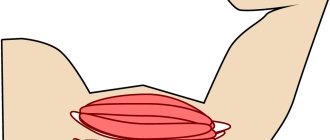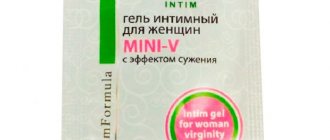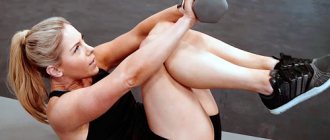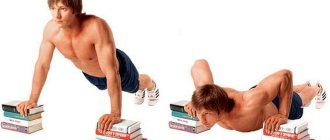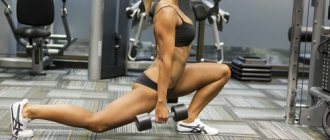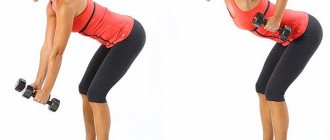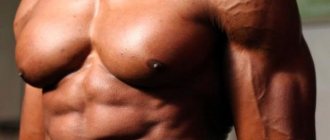- May 4, 2019
- Home workouts
- Tatiana Udalova
Often people who are engaged in building their dream figure forget about the calf muscles. However, they make a significant contribution to the harmonious appearance of the silhouette. From this article you will learn how to pump up your calves at home. Exercises and tips for getting better results are given below.
Anatomy
Let's start with a simple anatomy lesson. The calves are made up of two powerful muscles: the gastrocnemius and the soleus.
These two muscles work together to control the foot and ankle and are also involved in knee flexion. When it comes to appearance, we are most concerned with the gastrocnemius muscle, but proper development of the soleus is also extremely important as it supports the gastrocnemius both functionally and visually.
Genetics
There are two main types of muscle fibers:
- Slow fibers. They have lower growth and strength potential, but are resistant to fatigue.
- Fast fibers. They have a much higher potential for growth and strength output, but they tire quickly.
Research shows that the muscle fiber composition of the gastrocnemius muscle can vary significantly from person to person. For example, some people have 60% fast-twitch fibers, while others have only 15%. People in the first group will find it easy to add mass to their muscles (they may not even need to worry about a separate calf workout), while people in the second group will not be able to quickly build up their calves and will have to fight tooth and nail for every millimeter. progress. However, do not despair: with proper nutrition and training, anyone can achieve results. Some just take longer than others.
Below are 12 basic exercises for the calf muscles at home and in the gym.
How can a girl make her calves thinner?
We may be quite dissatisfied with the figure that nature has given us. Some girls have calves that are a little bigger than they should be. In this situation, you need to make your calves thinner.
If you have such a situation, do not rush to get upset. This problem can be solved very easily and quickly. In just 3-4 months of training you can get the calf muscles of your dreams. To do this you need to do the following exercises:
- Run. In addition to your calf muscles, you will improve the shape of other muscles in your legs. Moreover, lose those extra pounds and completely get your body in order. Working out the calf muscles is just a side effect of jogging here. Have you ever wondered why football players have chiseled and strong calves? Yes, because they run a lot. Go for a run three times a week and after 3 months you will notice the first results!
- Jumping rope. Many athletes neglect this exercise. And this is a big mistake! Jumping rope is what gives your calves their shape. This exercise is a must if you want to make your calves leaner. Jumping rope disperses congestion in the knee joints and removes fat deposits in the calf muscles. You need to start small. For example, from fifty jumps a day. Jump rope 3 times a week. Each training day, add 20-30 jumps. When you reach 500 jumps, just make jumping rope a habit. This will literally take you 5-10 minutes in the morning. But you will be in good spirits, and your calves will be in great shape.
- Walking on a stepper. This simulator simulates walking on stairs. It is walking up the stairs that pumps up the calf muscles very well, and also burns excess fat accumulated in the legs. In order to make your calves thinner, it is enough to work out for 3-4 months on this simulator. You need to exercise three times a week for 15–20 minutes.
For these exercises to give maximum results, they must be combined. For example:
- On Monday, you can jog at a slow pace in the morning and jump rope in the evening.
- On Wednesday morning you jump rope and walk on a stepper in the evening.
- On Friday from the tour you run at an average pace, and in the evening you walk on a stepper.
And besides these exercises, you need to walk a lot. It is possible that the reason your calf muscles are so shaped is due to a sedentary lifestyle. Movement is life! Walk more and constant work will become the norm for your calf muscles.
Seated leg raises with emphasis on toes
- Use a specialized machine if you're at the gym, or a bench if you're doing calf exercises at home.
- Sit on a bench and place your toes on a block or step (hold dumbbells on your thighs for added resistance).
- Your knees should be bent at a 90 degree angle. The toes may point straight or be slightly turned inward or outward. The choice depends on which part of the muscle you want to focus on.
- Start lowering your heels toward the floor until you feel a stretch in your calves.
- Then, resting your toes on the elevated surface, raise your heels as high as possible.
- Do 20 reps.
How to train calves
Anatomy of the calf muscles
Let's briefly go over the anatomy of the lower leg muscles. What we call the calves are made up of two muscles: the gastrocnemius and the soleus. The calf muscles are located high on the shin and function to lift the heels from a standing position.
The soleus muscle is located under the gastrocnemius in the depths of the lower leg. It serves to raise the heels from a sitting position. A developed soleus muscle pushes out the calf muscle of the leg, making it visually larger.
How can this be useful? To develop the calf muscles, you should use the most physiological exercises (don’t make up a bicycle - these are calf raises while standing and sitting), using both functions of these muscles.
Exercises to train your calves
The first and most important exercise in training your calves should be standing calf raises. Use a special simulator that will allow you to lower your heels below the horizontal - this way you will work with a large amplitude. Check out this article to understand how to properly perform standing calf raises. Put execution technique first:
- Do not bend your knees (a slight bend is acceptable as a way to remove stress from the knee joint).
- Work occurs only with the ankle joint.
- Do not pause at the bottom point to prevent your muscles from resting.
- Work through the full amplitude. Below is the maximum stretch, at the top is the peak contraction (pause for a second at the top point).
- The pace of the exercise is smooth.
- Choose the correct working weight without sacrificing technique.
- For a deeper calf workout, try doing single-leg raises.
The second exercise will be seated calf raises. The best option would be to use a special simulator. If you don’t have something like this in your gym, don’t despair. Place a block under your socks so that your heels can go below the horizontal, take dumbbells or a barbell, sit on a bench and place the weight on your knees. The principles of execution here are absolutely the same as in standing calf raises.
These two exercises will be enough for you to build up the shape of the calf muscles you need. Place them at the end of your workout, but don't take it lightly. Achieve a burning sensation on the last repetitions - this is a sure sign that you are doing everything right.
And don't worry about pumping up your calves. Firstly, you can stop at any time as soon as you achieve the desired shape and perform maintenance workouts, and secondly, in order to develop colossal calf muscles you need serious loads coupled with pharmacological drugs.
How many repetitions and sets should you perform?
Taking into account the above (the natural characteristics of the calf muscles and the characteristics of the female body), take the following program as a starting point:
- Warm-up
- Core workout
- Standing calf raises size 1-2. sets of 4-5 workers, 15-20 repetitions
- Seated calf raises size 1-2. sets of 4-5 workers, 15-20 repetitions
- Hitch
Do not perform exercises without warming up. If you do calf exercises at the end of the main workout, then your muscles will be warmed up and ready to work, no special warm-up is required. Select a working weight so that the last 2-3 repetitions are difficult, but you still perform the exercises with IDEAL technique.
Try to keep the pauses between approaches short (from 30 seconds to 1.5 minutes). Make it challenging for your muscles. At each new workout, increase the load on your calves at least a little: by adding 0.5 kg to the working weight, additional repetitions, etc.
After your workout, don't forget to cool down, which includes short cardio and stretching. A cool-down will prevent cramps and improve the access of nutrients to the muscles being trained, which contributes to their better recovery and, therefore, growth.
Conclusion
The article gives an understanding of a quick way to pump up a girl’s calves. The emphasis is on training in the gym, because... this will allow you to perform the most effective exercises and maintain the principle of load progression.
Take your workouts seriously, approach them with enthusiasm and passion, and complete your slim figure with the shape of your calves. Good luck!
Single leg calf raise
- Stand on a block or step with one foot, placing your body weight on your foot.
- Bend your free leg and place it behind your working leg.
- Begin to lower your heel into the floor, stretching your calf muscle.
- Hold for one second and then lift your heel and push yourself up. Hold the top position for two seconds.
- Do 20 reps.
- Change your working leg.
General recommendations
Remember to regularly train any muscles, not just calves
- Before doing a set of exercises to develop your calves, be sure to stretch the joints of your ankles and fingers and warm up the muscles themselves.
- After exercise, be sure to stretch your calf muscles. To do this, take a wide step back, placing your heel on the floor and leaning your body forward. Stretch for 10-20 seconds with each leg.
- The range of motion when performing exercises should be maximum.
- The load needs to be changed. Vary the exercises and load, otherwise addiction will occur, which will reduce the effect of the exercises.
- You need to train your calves two or three times a week, giving the muscles time to recover.
- Aerobics should be done at the beginning of the workout, and strength training on the calves should be completed. This is the only way to achieve calf growth.
- If you transfer weight to your thumbs when lifting, the load on the muscles will be better.
- To further complicate the exercises and pump up men's calves, hold for five counts at the top of the lift.
- When pumping up your calves, the main thing is not to overdo it and not overwork the muscles, otherwise you can bring yourself to cramps. And this is at least unpleasant.
Common mistakes when training calves
Let's look at the main mistakes that athletes make who are puzzled by how to quickly pump up their calves at home or in the gym:
- Perform calf exercises at the end of your leg workout. Pumping up this muscle group is often neglected or left until the end of leg training, when there is no strength left. Muscles cannot grow unless they are subjected to significant stress. So if you really want your calves to get ripped, you have to start training them the same way you train your back or chest: from all angles until you're completely exhausted. If you can start your leg workout with your calves and train them at the same intensity as your quads or glutes, do so. If your leg workout is too heavy, add calf exercises to another workout.
- Limit the rep range to 10-15. During your workout, do at least 20 repetitions per set of each exercise. Higher rep ranges force you to use slightly lighter weights, allowing you to fully contract the muscles and stimulate growth.
- Same workouts. Most people train their calves the same way every workout. Often they are the ones who wonder how to pump up their calves and increase their volume. If you only perform exercises while sitting or standing, then you are not hitting all the muscle heads equally. When you perform standing exercises, most of the work is done directly by the calf muscles. The soleus muscle, on the other hand, is activated when performing exercises with bent knees. Therefore, try to add variety to your training program.
- Too much weight. When working with too much weight, your technique suffers. In turn, the load is transferred to other muscle groups, for example, to the quadriceps or the back of the thigh. Thus, it is better to give preference to high-repetition training with light weights.
- Inability to isolate and fully compress the calves. Like any other muscle, the calves benefit most from exercise when they are performed with a full contraction, slow and full stretch. Many people like to drop the weight or just do partial reps without doing a full squeeze. Optimize the compression you get at the peak of each rep by standing on your toes and lifting yourself as high as possible. Once you're at the top, tense your muscles really hard. This requires conscious effort and focus. The work doesn't end once you reach peak contraction. Maintain tension in your muscles as you slowly return to the starting position. At the end of each repetition, gently, without sudden movements, stretch your calf as far as possible without shifting the focus of the stretch to the Achilles tendon. The load should remain on the target muscle and not on the connective tissue.
- Using incorrect foot positioning. With different positions of the legs, the calves are worked from different sides. With your feet pointing straight ahead, the inner and outer heads of your calves will be worked equally. Turning the toes inward will shift the focus to the inner heads, and pointing the toes outward will shift the focus to the outer heads. However, too much deflection not only prevents maximum muscle activation from being achieved, but also places undue stress on the ligaments and connective tissues of the ankles and knees. For best results, do not play at a high angle.
Exercises for calf muscles at home
At home you can not only watch TV, but also work on your body. Experienced fitness instructors say that home workouts are ineffective. But this is not so: the main thing is desire. Sports should be regular - 2-3 times a week.
If you overdo it and overload the body, you can get the opposite result. But you shouldn’t take too long breaks - you’ll have to wait a very long time for the desired changes, or you may not see them at all.
For independent exercise, it is better to choose a set of exercises for the calf muscles, but first you need to prepare these areas of the body.
Self-massage is good for this: for 10-15 minutes, apply pressure with your thumbs in the direction from the ankles to the knees. It is better to lubricate the skin with special oil or massage cream - this will help not stretch or damage the leg muscles.
A set of exercises to reduce volume
To successfully lose weight, the lower leg muscles must be very carefully stretched and exercises done not separately, but in combination with massage. Also, you can’t lose weight only in one specific part of the body. Fat disappears gradually in all places, so it is better to start the process of gaining slender legs by reviewing your diet.
First of all, it is important to establish a drinking regime: one glass of water every hour. You should not be afraid of swelling - if there are no problems with the kidneys and excessive cravings for salty and canned foods.
Next, review your diet as a whole - reduce the daily calorie content of your meals by about a third, this way you will be able to lose extra pounds much faster. In food we give preference to vegetables, fruits and lean meat or fish. Don't forget about physical activity.
Exercises for losing weight in the calf muscles:
You will need equipment for step aerobics.
- We stand with both feet on the step. Lower one leg forward and return to the starting position. 20 repetitions will be enough.
- We get up from the floor onto the platform alternately with our right and left feet. It is important to keep a fairly fast pace here. Perform for 15 minutes.
- Stand on the step with one leg, bend the other at the knee and raise it as high as possible, then lower it onto the step. Then we stand on the floor and repeat the exercise for the other leg - 30 repetitions.
Such exercises to reduce the size of the calf muscles can be done at home on any elevation, for example, on a step.
Muscle strengthening
In order to make the contours of your legs more prominent, it is enough to train them 2-3 times a week. In this case, it is better to start small, gradually increasing the duration of the lesson. Here you can turn to the help of professionals, but you can also achieve good results at home.
Exercises to strengthen the calf muscles:
- Standing on the floor, raise your toes as slowly as possible and lower them sharply down. Perform at least 150 repetitions at a time. But in the initial stages it is allowed to perform 5 approaches up to 30 times.
- The exercise is similar to the previous one, but you will need dumbbells. You should choose them taking into account your physical condition: these can be 1 kg weights for beginners or 4-7 kg for professionals. The main thing is to maintain balance.
- Let's spring alternately with the right and then with the left foot. You can pick up dumbbells, but it is not forbidden to complete this task without them.
Program for the inner part of the calf muscle
You can work out this muscle group perfectly with regular squats (4 sets of 20 repetitions).
Exercises for the inner part of the calf muscle:
- Stand up straight. As you inhale, lean forward and touch the floor with your palms. Next, we squat without lifting our heels from the floor. Straighten your legs. We make all transitions slowly. 20 reps.
- Standing, put one leg slightly forward, the other back. As you inhale, bend forward and touch your palms to the floor. Pull the toes of one leg in without bending the knee. Then direct it away from you. 10 reps for each leg.
- Sitting on the floor, bend your knees. Place a small fitball between them. Lean back onto your forearms and lift your legs up. Stay in this position for 15 seconds. Repeat 15 times. At first, this exercise may seem very difficult or impossible to do. But this is just the beginning. Try reducing the duration to 4-5 seconds, gradually adding a little at a time.
- “Pistol”: stand on your right leg, bend your left knee. As you exhale, perform a squat and sit there for 10 seconds. Then gradually straighten the right one. Repeat similarly for the other leg.
- standing, the distance between the legs is 3-4 cm. Raising your heels high from the floor, transfer your body weight to your toes. In this position, take several steps. Next, stand on your heels and walk the same distance. Perform for 10 minutes.
Workout for women
The love for heels does not pass without a trace and, although yesterday they seemed quite slender, today our legs clearly lack their former lightness and elegance. After all, heels are also a training device that forces the calves to be in constant tension.
That is why representatives of the fair sex often have excessively voluminous ankles. Gradually, ladies begin to develop complexes and short skirts are replaced by midi skirts, and then by completely loose-fitting trousers.
To avoid these troubles, girls need to take care in advance about how their beautiful legs will look in a few years. You need to adopt a few simple exercises and do them a couple of times a week.
Exercises for the calf muscles for women and girls:
- While standing, we put one leg back, while it should touch the floor only with its toes. Then you should try to reach the floor with the heel of this leg. In this case, the body is motionless, only the leg muscles are tense.
- While sitting, we stretch our legs in front of us and rest our hands behind us. We are trying to reach the buttocks with our heels. It is important not to lift your feet off the floor. Both legs work simultaneously.
- Standing, without lifting your heels from the floor, perform squats. You don't have to sit all the way down.
But there are times when a lovely lady is simply not satisfied with the shape of the lower part of her leg. Then it can be corrected with the help of comprehensive training.
Exercises to develop calf muscles for women:
- Standing, feet shoulder-width apart, squat, standing on your toes. A straight back is required. We move our butt back and very slowly return to the starting position. 4 sets of 20 reps. It's better to do it with dumbbells.
- Take a dumbbell in each hand and stand on your toes. Walk around the house like this for 15-20 minutes.
- We walk up the stairs. Our favorite dumbbells are in our hands. We try to stand on the step with our toes. Perform for 10 minutes.
- The main thing here is regularity of classes. Only in this case can you count on good results.
Exercises for men
For the strong half of humanity, a toned figure, including legs, is no less important than for lovely ladies. Nowadays, healthy, pumped-up guys are in fashion, and this is good news. Men are naturally stronger, so it may take more time and effort to build beautiful legs. To achieve good results, it is better to use dumbbells with a weight of 14-17 kg.
Effective calf exercises for men:
- Starting position - squat. You need to squat down with dumbbells and jump as high as possible. 30 reps.
- We do lunges: we walk alternately, while the step width is maximum. Be sure to have dumbbells in your hands. 40 “steps” are enough. 4 approaches.
